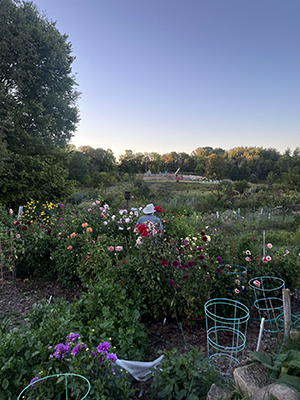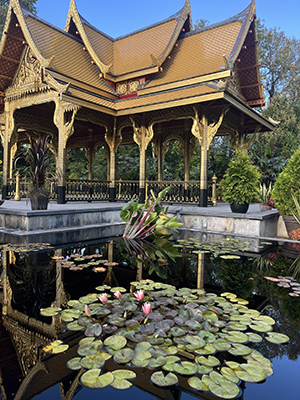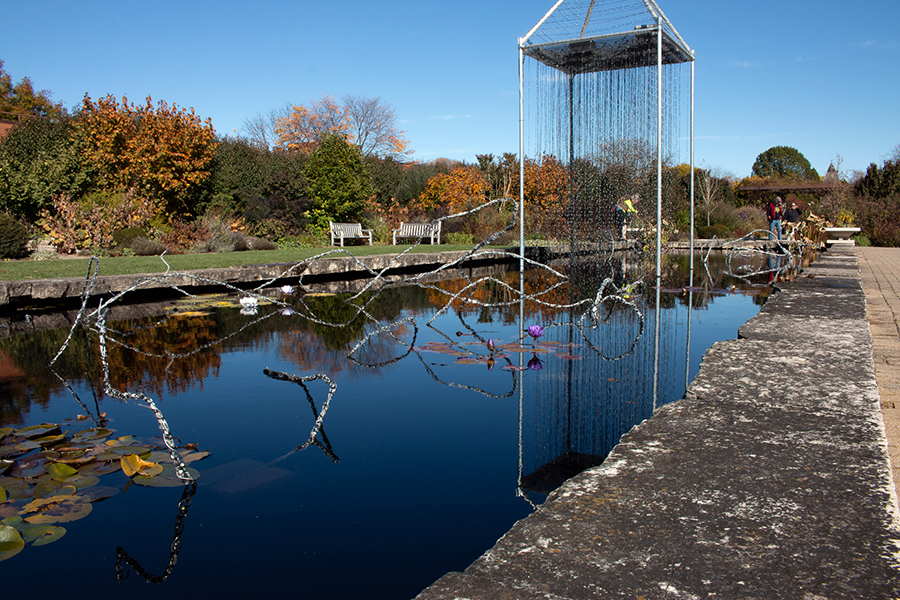Olbrich Botanical Gardens showcases a balance between the beauty of nature and the impact of its environmental awareness. From the moment you enter, the gardens already display a variety of plants that act as lessons to learn from in Botany. Within its 16-acre area lies a series of different connected gardens, each one being unique.
Moments upon entering the gardens, you can already smell the flowers in full bloom. Entrance is free of charge and for all ages. The entrance itself sets its very own tone for the entirety of the visitors’ experience. When entering, there is a cozy gift shop on the left and the admin desk is located towards a window to the center of the room, where a staff member can help with anything and history, upcoming events, educational resources, and map brochures are available to ease the visitors’ experience. Beyond the indoor entrance, you’ll walk out to find a wide variety of trees, flowers, and birds. You can choose to walk through several different directions as each one offers a different kind of scenic view. There’s a centered circle which is where most of the events tend to happen and to the right is a short pathway with a water fountain in the center. On both sides are different plants, some of the most recurring ones are the different-colored spider flowers and geraniums. One of my favorite spots is the butterfly bed, which is alive with activity in the very early morning when you can see these butterflies flitting between flowers.

At Olbrich Gardens, each plant is meticulously labeled with its own scientific name and origin, which enhances the visitors’ educational experience and quickly responds to the curiosity they carry. It is very peaceful, uncrowded, and diverse with its many kinds of trees planted. One thing I love about Olbrich is that it’s designed to be enjoyed in every season. There are benches and long walkways where you can either take a quiet tour or sit in silence and listen to the nature around you take its course. During a visit earlier this winter, I went in the morning and saw many friendly volunteers tending to the plants and harvesting new ones. Most of the volunteers were older and seemed to do this as a hobby in their free time and to help keep these plants alive and nourished.
Olbrich Gardens targets an audience of all ages, from babies to adults – it truly is a great place for anyone to unwind or go to learn more about botany and plant preservation. There is always a great quiet place to walk through or a spot for children to be loud and play in, which is why this environment is extremely versatile.
The gardens were originally named after Michael B. Olbrich, who was born in 1881. He purchased a piece of land on the shore of Lake Monona and turned it into a park. Due to his envisioning it as a garden, he spent years planting different kinds of plant species and working his way toward creating his goal. After his death, John Olin redesigned a few parts and greatly expanded the park into what is now Olbrich Botanical Gardens, in honor of Michael’s memory. In 1952, it became what we know and see now- an official botanical garden; since then, many additions have been made, including pools, statues, and new plant species planted throughout the grounds.
Olbrich has all kinds of gardens including a rose garden and a large conservatory. The Bolz Conservatory spans over 10,000 feet and is home to 650 different species of plants. It is very committed to sustainability and keeping its botanical environment at its healthiest state. For visitors looking to enjoy the gardens in other ways, Olbrich offers many events, the most recent one being the nighttime gleam event, for all ages.
The striking variety of colors is one of the first things you’ll notice on your visit, especially in spring and autumn. Flowers are in full bloom, and the hues of the changing leaves blend with the bees and birds flying over the trees. You’ll come across clear blue streams as well as green ones covered in algae, where turtles often sit and rest. In winter, snowfall blankets the plants, creating a white cast that adds a different beauty to these landscapes. Aside from several pathways to get to these areas, different bridges connect the visitors to other gardens nearby.
The great educational aspect that Olbrich has to offer is just as interesting, however. Their main priority is restoring native plants in Madison and staying energy efficient. One of the ways they do that is through hands-on workshops for people to join, educational programs/ youth programs, and lectures that people can listen to and gain knowledge about environmental sustainability. These events can always be found online. Another efficient fact about Olbrich- is that they use rain gardens to capture rainwater and help it seep into the ground rather than go into some drains.

The way the garden is built is almost like a maze, with each direction taking you to a different garden that offers any sort of seating arrangement for those who want to sit and focus on reading, drawing, or just the nature around them. A recurring theme in most of them is the addition of small ponds or wetlands home to frogs, turtles, and dragonflies. Each garden plays a different role in the overall theme at Olbrich. Some can feel and appear peaceful and calm while others feel cheerful and look vibrant. The only time I’d seen the gardens relatively crowded was during the nightly events, and even then, it came alive in a good way. These events help bring people together, and while doing so, they further spread the main message of sustainable development that Olbrich has always vouched for.
Aside from the clear fact that these gardens are physically appealing, they’re also highly therapeutic. Being in nature usually enables our five senses and allows us to feel much calmer and more in tune with ourselves.
There are many artistic details within these gardens to point out. Along areas behind The Thai Pavilion, certain statues are sat along the sidewalk. While walking, it made me think about what it must’ve been like for volunteers and staff workers to protect these plants and artifacts during harsh weather. Upon doing research, I found that most of these plants are picked based on their resilience to quick and harshly changing climate conditions. Some of the main colors you’ll note are green (for the plants and leaves everywhere), brown (for the rocky buildings that offer a scenic view from atop), red (for the roses and different flowers), and blue (for the waters in almost every direction). Walking along each of these paths evokes a sense of tranquility. In almost every season, the plants carry a soft, gentle breeze that makes it even more peaceful.
Some of the main sounds you’ll often hear are quiet crickets, birds chirping, or the occasional sounds of a large or small waterfall nearby. If you’re lucky, you might find some of the turtles that were usually in hiding too. You’ll also come across lily pads on the water of the Royal Thai Pavilion. Olbrich has hosted many events over the years, one of them being the Sala Thai event in honor of Thai culture and the relations between Thailand and the United States.



























